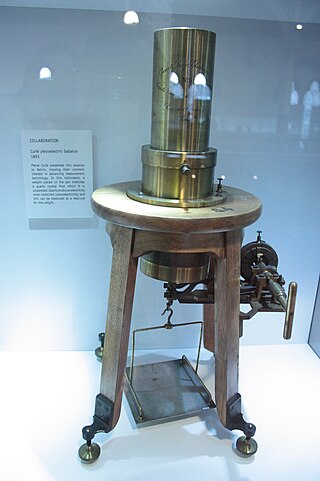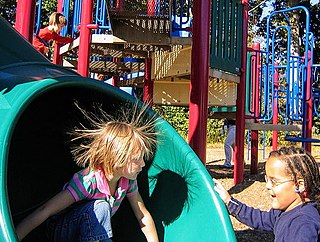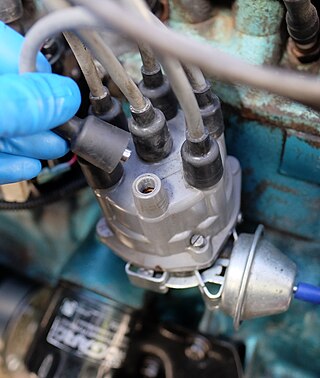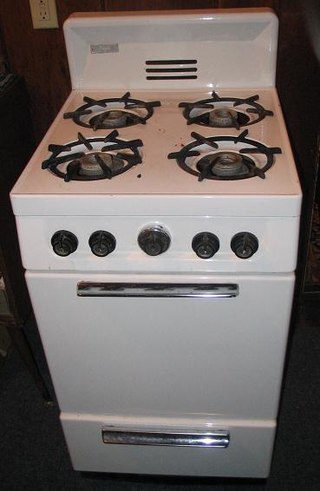
Piezoelectricity is the electric charge that accumulates in certain solid materials—such as crystals, certain ceramics, and biological matter such as bone, DNA, and various proteins—in response to applied mechanical stress. The word piezoelectricity means electricity resulting from pressure and latent heat. It is derived from Ancient Greek πιέζω (piézō) 'to squeeze or press', and ἤλεκτρον (ḗlektron) 'amber'.

Static electricity is an imbalance of electric charges within or on the surface of a material. The charge remains until it is able to move away by an electric current or electrical discharge. The word "static" is used to differentiate it from current electricity, where an electric charge flows through an electrical conductor.
In spark-ignition internal combustion engines, knocking occurs when combustion of some of the air/fuel mixture in the cylinder does not result from propagation of the flame front ignited by the spark plug, but when one or more pockets of air/fuel mixture explode outside the envelope of the normal combustion front. The fuel–air charge is meant to be ignited by the spark plug only, and at a precise point in the piston's stroke. Knock occurs when the peak of the combustion process no longer occurs at the optimum moment for the four-stroke cycle. The shock wave creates the characteristic metallic "pinging" sound, and cylinder pressure increases dramatically. Effects of engine knocking range from inconsequential to completely destructive.

A lighter is a portable device which creates a controlled flame, and can be used to ignite a variety of flammable items, such as cigarettes, butane gas, fireworks, candles or campfires. A lighter typically consists of a metal or plastic container filled with a flammable liquid, a compressed flammable gas and in rarer cases a flammable solid i.e. rope in a trench lighter, a means of ignition to produce the flame, and some provision for extinguishing the flame or merely controlling it to such a degree that the user may extinguish it with their breath. Alternatively, a lighter can be one which uses electricity to create an electric arc utilizing the created plasma as the source of ignition or a heating element can be used in a similar vein to heat the target to its ignition temperatures, as first formally utilized by Friedrich Wilhelm Schindler to light cigars and now more commonly seen incorporated into the automobile auxiliary power outlet to ignite the target material. Different lighter fuels have different characteristics which is the main influence behind the creation and purchasing of a variety of lighter types.

Ignition systems are used by heat engines to initiate combustion by igniting the fuel-air mixture. In a spark ignition versions of the internal combustion engine, the ignition system creates a spark to ignite the fuel-air mixture just before each combustion stroke. Gas turbine engines and rocket engines normally use an ignition system only during start-up.

A distributor is an electric and mechanical device used in the ignition system of older spark ignition engines. The distributor's main function is to route electricity from the ignition coil to each spark plug at the correct time.
A buzzer or beeper is an audio signaling device, which may be mechanical, electromechanical, or piezoelectric. Typical uses of buzzers and beepers include alarm devices, timers, train and confirmation of user input such as a mouse click or keystroke.

A gas stove is a stove that is fuelled by combustible gas such as syngas, natural gas, propane, butane, liquefied petroleum gas or other flammable gas. Before the advent of gas, cooking stoves relied on solid fuels such as coal or wood. The first gas stoves were developed in the 1820s and a gas stove factory was established in England in 1836. This new cooking technology had the advantage of being easily adjustable and could be turned off when not in use. The gas stove, however, did not become a commercial success until the 1880s, by which time supplies of piped gas were available in cities and large towns in Britain. The stoves became widespread on the European Continent and in the United States in the early 20th century.

A piezoelectric motor or piezo motor is a type of electric motor based on the change in shape of a piezoelectric material when an electric field is applied, as a consequence of the converse piezoelectric effect. An electrical circuit makes acoustic or ultrasonic vibrations in the piezoelectric material, most often lead zirconate titanate and occasionally lithium niobate or other single-crystal materials, which can produce linear or rotary motion depending on their mechanism. Examples of types of piezoelectric motors include inchworm motors, stepper and slip-stick motors as well as ultrasonic motors which can be further categorized into standing wave and travelling wave motors. Piezoelectric motors typically use a cyclic stepping motion, which allows the oscillation of the crystals to produce an arbitrarily large motion, as opposed to most other piezoelectric actuators where the range of motion is limited by the static strain that may be induced in the piezoelectric element.

Ferrocerium is a synthetic pyrophoric alloy of mischmetal hardened by blending in oxides of iron and/or magnesium. When struck with a harder material, the mixture produces hot sparks that can reach temperatures of 3,315 °C (6,000 °F) when rapidly oxidized by the process of striking the rod. Striking both scrapes fragments off, exposing them to the oxygen in the air, and easily ignites them by friction heat due to cerium's remarkably low ignition temperature of between 150 and 180 °C.

An electric match is a device that uses an externally applied electric current to ignite a combustible compound.
Auto reignition is a process used in gas burners to control ignition devices based on whether a burner flame is lit. This information can be used to stop an ignition device from sparking, which is no longer necessary after the flame is lit. It can also be used to start the sparking device again if the flame goes out while the burner is still supplying gas, for example, from a gust of wind or vibration.
Walter Guyton Cady was a noted American physicist and electrical engineer. He was a pioneer in piezoelectricity, and in 1921 developed the first quartz crystal oscillator.
A piezo switch is an electrical switch based on the piezoelectric effect.
Amplified piezoelectric actuators are specific actuators using piezoelectric materials as active material and have a specific design to overcome traditional limitations of classical direct piezoelectric actuators, the limited stroke. As classical piezoelectric materials have a strain of 0.1%, it is practically impossible to reach significant stroke without displacement amplification. The solution to reach middle range stroke is to use an amplification system.
In firearms and artillery, the primer is the chemical and/or device responsible for initiating the propellant combustion that will propel the projectiles out of the gun barrel.
A gas lighter is a device used to ignite a gas stove burner. It is used for gas stoves which do not have automatic ignition systems. It uses a physical phenomenon which is called the piezo-electric effect to generate an electric spark that ignites the combustible gas from the stove’s burner.

This is an alphabetized glossary of terms pertaining to lighting fires, along with their definitions. Firelighting is the process of starting a fire artificially. Fire was an essential tool in early human cultural development. The ignition of any fire, whether natural or artificial, requires completing the fire triangle, usually by initiating the combustion of a suitably flammable material.
A complex oxide is a chemical compound that contains oxygen and at least two other elements. Complex oxide materials are notable for their wide range of magnetic and electronic properties, such as ferromagnetism, ferroelectricity, and high-temperature superconductivity. These properties often come from their strongly correlated electrons in d or f orbitals.
This article provides information on the following six methods of producing electric power.
- Friction: Energy produced by rubbing two material together.
- Heat: Energy produced by heating the junction where two unlike metals are joined.
- Light: Energy produced by light being absorbed by photoelectric cells, or solar power.
- Chemical: Energy produced by chemical reaction in a voltaic cell, such as an electric battery.
- Pressure: Energy produced by compressing or decompressing specific crystals.
- Magnetism: Energy produced in a conductor that cuts or is cut by magnetic lines of force.










